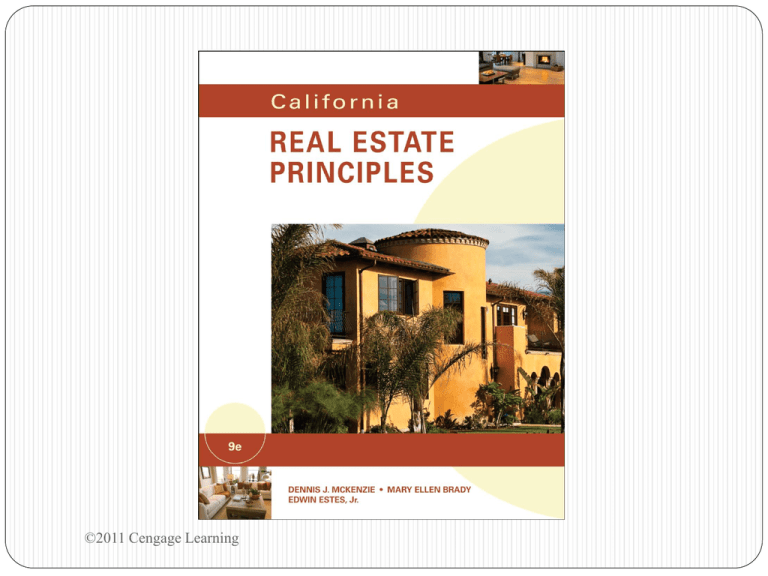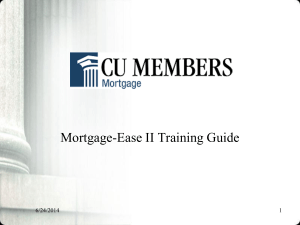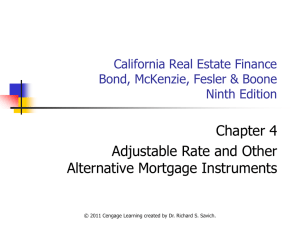
©2011 Cengage Learning
California Real Estate
Principles
Chapter 7
Introduction to Real Estate
Finance
©2011 Cengage Learning
Chapter 7
1.
2.
3.
4.
Describe the types of promissory notes, then
explain adjustable rate loans.
Explain a deed of trust (trust deed), a
mortgage, installment sales contract, and
foreclosure procedures.
Define clauses common to financing
documents: acceleration, alienation,
subordination, prepayment penalty.
Outline the principles of loan regulations:
Truth-In-Lending, RESPA, Fair Credit, Real
Fair Credit Reporting and Property Loan Law.
©2011 Cengage Learning
Financing Process
1.
2.
3.
4.
5.
APPLICATION: Lender form used to acquire
information on income, credit and assets.
ANALYSIS: Verification of income, credit and
assets. Underwriter decides if borrower is qualified.
If so, loan terms. The major issue the FICO score
PROCESSING: Papers drawn. Escrow instructions,
appraisal, loan documents.
CLOSING: Papers signed, loan funds, loan and
escrow closes, documents recorded, insurance
issued (property and title), closing statements issued
SERVICING: Process of collecting loan payments.
Check on loan until paid off. Pay impound bills.
©2011 Cengage Learning
Phases of the Financing Process
1. APPLICATION
-income, debts, net worth
2. ANALYSIS
-FICO score, ability to pay, appraise property
3. PROCESSING
-draw papers and escrow instructions
4. CLOSING
-loan is funded, documents recorded, escrow closing statements
5. SERVICING
-collecting payments and monitoring loan
©2011 Cengage Learning
Overview of Finance Documents
Financing Instruments
Note
Promise to RePay
Hypothecate
Security
Collateral Lien
Straight Note
Mortgage
Amortized Note
Deed of Trust
Land Contract
Partially Amortized
Fully Amortized
©2011 Cengage Learning
Installment Note
Negative Amortized Note
This is when the loan payment does not cover the
monthly interest
Shortage is added to principal loan amount
Results in increased loan balance
©2011 Cengage Learning
Promissory Notes (SAFI )
Legal evidence for the debt
S traight Note – term note
Payments of Interest Only
Entire principle repaid on the final due date
A mortized Note
Monthly payments which include both Principal and Interest
F ully amortized type--Liquidates the debt with final payment
Partially amortized (balloon payment type requires larger final
payment)
I nstallment Note
Periodic payments of principal & interest
©2011 Cengage Learning
Real Estate Loans
Fixed Rate - The interest rate remains the same
Adjustable Rate Mortgage (ARM)-rate
Lower initial rate than fixed-rate mortgage
Rate cap and payment cap
Variable Interest Rate (VIR)
Graduated Payment Mortgage (GPM)-increasing
Graduated Payment Adjustable Mortgage
(GPAM)
Growing Equity Mortgage (GEM)principal
All-Inclusive Trust Deed (AITD)
Reverse Annuity Mortgage (RAM)
©2011 Cengage Learning
VARIABLE PAYMENT PLANS
7
6
5
Loan Interest
Rate
Treasury
Securities Rate
4
3
2
1
0
Year
1
Year
2
Year
3
Year
4
Year
5
Year
6
The interest rate may change and as a result the
following may be affected:
1. Payments
2. Principal owed
3. Term (length of the loan)
©2011 Cengage Learning
Adjustable Rate Loan TERMS
INDEX: Measures need for a change in rate.
MARGIN: The distance between actual and index
rate.
ADJUSTMENT PERIODS: How often rate
changes. Typically every 6 or 12 months.
CAP: Maximum rate over initial rate.
TEASER: Very low initial rate for short period
before increase to normal ARM rate.
CONVERTIBLE: During “window period” (2-5
years) allowed to switch to fixed rate upon
payment of fee.
©2011 Cengage Learning
DEED OF TRUST
(Trust Deed)
Easier, cheaper, faster foreclosure
Creates a lien to secure repayment of a note
Trustor – Borrower
Trustee – Stakeholder or “naked” Titleholder
Beneficiary – BANK - Lender
Trustor
When debt
is paid
Deeds to
Trustee
Who holds title
until debt is paid
Reconveys
Trustor
Trustee
The Trustee returns title to the Trustor by a Deed of Reconveyance
©2011 Cengage Learning
Mortgagor - Borrower
MORTGAGE
(A Contract)
Mortgagee - Lender
Loan Payoff
Satisfaction of Mortgage
Foreclosure by default
Law suit / Court order
Decree of Foreclosure
Notice of Sale
Sheriff’s Sale
Sheriff’s Deed
Deficiency Judgment possible
One-year Period of Redemption
©2011 Cengage Learning
Common Provisions in
Security Instruments
Acceleration
Clause
Alienation
(Due-On-Sale)
Clause
Lock-In
Clause
©2011 Cengage Learning
or
Assumption
Provision
or
Prepayment
Provision
TRUST DEED vs. MORTGAGE
Deed of Trust
Comparison
If Foreclosure by Court Action: Same
as for Mortgage
Trustee’s Sale - No Deficiency
Judgment Possible
Lender’s
Rights
If Foreclosure by Court Action: Same
as for Mortgage
Trustee’s Sale
Notice of Default – Owner may
redeem by bringing payments current
within three months
Notice of Sale – Owner may redeem
only by paying entire indebtedness in
full Trustee’s Sale Sale final. No
redemption
Owner’s
Rights of
Redemption
Before Decree of Foreclosure
Owner may redeem anytime by
bringing payments current
After Decree of Foreclosure and Sale
Owner has one year “Equity of
Redemption”
Must pay indebtedness in full to
redeem
Trust Note – Outlaws four years after
due date
Trust Deed – Never outlaws – Lender
can always have trustee sell to
recover unpaid balance
Stature of
Limitations
Mortgage note and contract both
outlaw four years from due date, or
from date of last payment. No relief.
Monies involved not collectable.
©2011 Cengage Learning
Mortgage
Possible Deficiency Judgment
Mortgage versus Trust Deed
Mortgage
Deed of Trust
Foreclosure
Court action Only
Equitable Redemption
Notice of Default
Lawsuit/Court
Notice of Sale
Statutory Redemption
Sheriff’s Sale
Deficiency Judgment
Sheriff’s Deed
1 year to redeem
Court Action or Trustee’s Deed
Reinstatement Period
Notice of Default/3 months
Notice of Sale
21 day minimum publish
Trustee’s Sale
All sales final
Trustee’s Deed
No redemption
Owner’s
Rights of
Redemption
Before Decree of Foreclosure
Owner may redeem anytime by
bringing payments current
After Decree of Foreclosure and
Sale
Owner has one year “Equity of
Redemption”
Must pay indebtedness in full to
redeem
If Foreclosure by Court Action: Same as
for Mortgage
Trustee’s Sale
Notice of Default – Owner may redeem by
bringing payments current within three
months
Notice of Sale – Owner may redeem only
by paying entire indebtedness in full
Trustee’s Sale Sale final. No redemption
©2011 Cengage Learning
Buyer Takes Over Seller’s Loan
Buyer assumes existing loan
Substitution of Liability
Buyer takes title “Subject to” existing loan.
©2011 Cengage Learning
Prepayment Penalty
Certain California lenders prohibited from
charging prepayment penalty on owneroccupied home loans if the loan has been on
the lender’s books for more than 3 years.
Does not apply to federally supervised lenders
No prepayment penalty on FHA, VA, or CalVet loans
©2011 Cengage Learning
SECOND DEED OF TRUST
Junior Lien – Purpose: Close the gap between the
sales price and the first loan plus down
payment
Types: “Hard” money second – cash from lender
“Soft” money second – credit from seller
Default: Junior lienholder may foreclose
REQUEST FOR COPY OF NOTICE
OF DEFAULT AND SALE
Purpose: To inform holders of junior
liens when the holder of a senior lien
(deed of trust) is about to foreclose
©2011 Cengage Learning
SALES CONTRACT
Land Contract or Installment Sales Contract
Vendor - Vendee
Low down payment usually required
Allows marginal buyer to acquire real estate
Buyer gets immediate possession
Buyer receives full legal title after loan paid off
Seller must follow statutory notice
requirements if buyer defaults
All parties should consult their attorney
Vendee may receive poor title.
Vendor may have problems during the term.
©2011 Cengage Learning
Sales Contract (cont.)
Buyer usually receives equitable, insurable,
recorded title
The contract cannot prohibit recording
Creates a cloud on vendor’s title
Removed by court or vendee signing a quitclaim
deed
Vendee may assign all rights if no release from
vendor
©2011 Cengage Learning
Basic Rule of Finance
If you don’t pay … they will take it away !
©2011 Cengage Learning
TRUSTEE’S SALE STEPS
1. Beneficiary requests trustee to foreclose
2. Trustee records Notice of Default
3. Three-month waiting period
(Borrower has reinstatement period)
4. Advertise “Notice of Sale” with date, time and
place of sale
(Borrower has limited right to reinstate)
Sale to highest bidder for cash
(loan amount + costs)
6. Trustee’s deed is issued (all sales final;
borrower has no right of redemption)
7. Disbursement of funds
5.
©2011 Cengage Learning
TRUTH IN LENDING LAW
Regulation Z (TIL)
Purpose – disclosure of credit
A.P.R. – cost of credit in
percentage
terms
Right of rescission
Annual Percentage Rate (APR)
be stated when
advertising financing
©2011 Cengage Learning
must
Equal Credit
Opportunity
Act
Enforced by the Board of Governors of the Federal Reserve System,
through the Federal Reserve Board.
• Prohibits lender or mortgage broker from discriminating against
credit applicants on the basis of race, color, religion, national origin,
sex, marital status, or age, among other things.
• Lender cannot ask borrower if: divorced, separated, has
childbearing plans, receives alimony or child support (unless using
the income to qualify for the loan).
• Lender has 30 days to approve or disapprove.
• If not approved, lender must state why.
©2011 Cengage Learning
Fair Credit
Reporting Act
Requires that, if a loan is denied, lender or mortgage
broker must:
• Give applicant a statement of denial reasons.
• Include the name of the federal agency that can be
contacted if the applicant feels discriminated against.
• If denial is based on information contained in the
applicant’s credit report, inform applicant of the right to
receive a free copy of the report, and how to do so.
• Information can be obtained from the Board of
Governors of the Federal Reserve System, through the
Federal Reserve Board.
©2011 Cengage Learning
Real Estate Settlement
Procedures Act (RESPA)
Requires lender or mortgage broker to disclose any
affiliated business arrangement with an individual
or entity offering settlement services.
• Special information booklet (Buying your Home:
Settlement Costs and Helpful Information) within three
days of loan application.
• Good Faith Estimate of settlement service charges
must be provided within 3 business days of loan
application.
©2011 Cengage Learning
HUD–1
Settlement Statement
May inspect one day before closing
Includes disclosure of lender-paid broker fees
Escrow Account Statement
No more than two months of excess payments
Accounting provided within 45 days
Annual review of escrow account
www.hud.gov
©2011 Cengage Learning
Mortgage Broker Limits
COSTS:
Limits amount of costs and expenses
Cannot be over 5% of the loan amount
Actual costs, or
$390
Cannot exceed $700 for costs and expenses.
©2011 Cengage Learning
Review Quiz Chapter 7
1.
A real estate promissory note that reads “$100,000
principal payable interest only monthly at a rate of
10%” is what type of promissory note?
a. straight
b. installment
c. principal and interest
d. accommodation
©2011 Cengage Learning
Review Quiz Chapter 7
2. A real estate promissory note reads “$887.50 per
month for 239 payments, then a final monthly
payment of $3,011.19.” This is an example of a/an:
a) Alienation payment
b) Prepayment
c) Balloon payment
d) Amortized payment
©2011 Cengage Learning
Review Quiz Chapter 7
3. An enforceable due-on-sale clause is correctly called
a/an:
a. acceleration clause
b. alienation clause
c. wrap around clause
d. prepay clause
4. In a normal sale using both a grant deed and a trust deed
(deed of trust) the buyer is the:
a. grantor and trustor
b. grantor and trustee
c. grantee and trustee
d. grantee and trustor
©2011 Cengage Learning
Review Quiz Chapter 7
5. A type of financing instrument where the owner
(vendor) retains the legal title until the buyer (vendee)
fulfills the terms of the purchase contact:
a. lease contract
b. installment sales contract
c. wraparound contract
d. junior lien contract
©2011 Cengage Learning
Review Quiz Chapter 7
6. Under the Trustee’s Sale procedure, after a Notice of
Default has been recorded, a borrower has how long
to reinstate by making up past payments, penalties,
late charges, and trustee expenses?
a. 5 days prior to trustee’s sale date
b. 90 days
c. 3 months
d. 1 year
©2011 Cengage Learning
Review Quiz Chapter 7
7. A mortgage broker negotiated a loan for $10,000
secured by a second trust deed to be paid in 30
monthly payments. The maximum commission the
broker is permitted to charge is:
a. $195
b. $390
c. $700
d. $1,000
©2011 Cengage Learning
Review Quiz Chapter 7
8. An owner sells and the buyer takes over the existing
loan. To relieve the seller of primary liability, the
buyer must:
a. sign a non-recourse agreement
b. take title contingent upon the note and trust deed
c. take title subject to the note and trust deed
d. assume the note and trust deed
©2011 Cengage Learning
Review Quiz Chapter 7
9. In an ARM loan, the distance between the borrower’s
rate and the index is called the:
a. cap
b. adjustment
c. margin
d. teaser
©2011 Cengage Learning
Review Quiz Chapter 7
10. Under the Real Property Loan Law the maximum
amount a borrower can pay for closing cots,
excluding commission, regardless of the size of the
loan, is:
a. 5%
b. $390
c. $700
d. $900
©2011 Cengage Learning
Answers to Review Quiz Chapter 7
1. A
6. A
2. C
7. D
3. B
8. D
4. D
9. C
5. B
10. C
©2011 Cengage Learning









